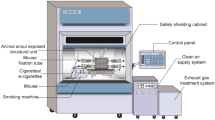Abstract
Previous studies from this laboratory have shown that α1proteinase inhibitor (α1-PI) can be inactivated by aldehydes found in the cigarette smoke as well as by industrial chemicals. Studies presented here demonstrate the synergistic inactivation of α1-PI by styrene oxide or 1,2-dichloroethane when mixed with acrolein or pyruvic aldehyde and vice-versa. The data suggest that smokers exposed to chemicals in industry may be more prone to lung emphysema due to synergistic inactivation of α1-PI by chemicals and cigarette smoke components.
Similar content being viewed by others
References
Ansari GAS, Gan JC, Barton BK (1987)In vitro inactivation of plasma, α1-proteinase inhibitor by epoxides and 1,2-dihaloethanes. Arch Environ Contam Toxicol 17:537–542
Bieth JG, Spies B, Wermuth CG (1974) The synthesis and analytical use of highly sensitive and convenient substrate of elastase. Biochem Med 11:350–369
Dooley MM, Pryor WA (1982) Free radical pathology: Inactivation of human α1-proteinase inhibitor by products from the reaction of nitrogen dioxide with hydrogen peroxide and the etiology of emphysema. Biochem Biophys Res Commun 106:981–987
Erlanger BF, Kokowsky N, Cohen W (1961) The preparation and properties of two new chromogenic substrates of trypsin. Arch Biochem Biophys 96:271–278
Gan JC, Ansari GAS (1986) Non-oxidative inactivation of plasma α1-proteinase inhibitor by carbonyl compounds found in cigarette smoke. Res Commun Subs Abuse 7:59–69
— (1987) Plausible mechanism of inactivation of plasma α1 proteinase inhibitor by acrolein. Res Commun Chem Path Pharmacol 55:419–422
Kueppers F, Beam AG (1966) A possible experimental approach to the association of hereditary α1-antritrypsin deficiency and pulmonary emphysema. Proc Soc Exp Biol Med 121:1207–1209
Laurent P, Bieth JG (1985) Cigarette smoke decreases the rate constant for the association of elastase with α1-proteinase inhibitor by a non-oxidative mechanism. Biochem Biophys Res Commun 126:275–281
Schauenstein E, Esterbauer H, Zollner H (1977) Aldehydes in Biological Systems, Chap 3, α,β-unsaturated aldehydes. Metheun Inc, New York, pp 25–34
Travis J, Beatty K, Matheson N (1984) Oxidation of α1,-proteinase inhibitor: Significance for pathobiology. Adv Exp Med 167:89–98
Author information
Authors and Affiliations
Rights and permissions
About this article
Cite this article
Ansari, G.A.S., Gan, J.C. & Barton, B.K. Synergistic inactivation of plasma α1-proteinase inhibitor by aldehydes of cigarette smoke with styrene oxide and 1,2-dichloroethane. Arch. Environ. Contam. Toxicol. 17, 533–536 (1988). https://doi.org/10.1007/BF01055520
Received:
Revised:
Issue Date:
DOI: https://doi.org/10.1007/BF01055520




